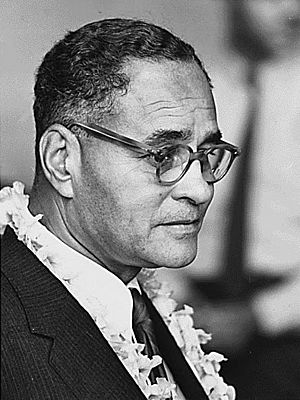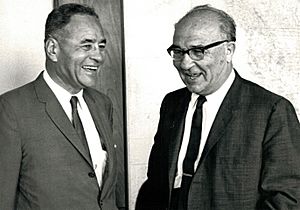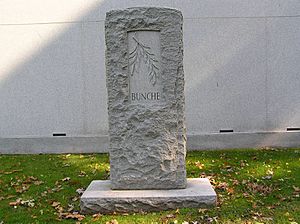Ralph Bunche facts for kids
Quick facts for kids
Ralph Bunche
|
|
|---|---|

Bunche at the 1963 March on Washington for Jobs and Freedom
|
|
| Born |
Ralph Johnson Bunche
August 7, 1904 Detroit, Michigan, U.S.
|
| Died | December 9, 1971 (aged 67) New York City, U.S.
|
| Alma mater | UCLA (BA) Harvard University (PhD) Northwestern University London School of Economics |
| Known for | Mediation in Israel, Nobel Peace Prize laureate |
| Children | 3 |
| Relatives | Ralph J. Bunche III (grandchild) |
| Signature | |
Ralph Johnson Bunche (born August 7, 1904 – died December 9, 1971) was an important American diplomat and political scientist. He played a big role in helping countries gain independence from colonial rule. He also worked hard for civil rights in the United States.
In 1950, Ralph Bunche won the Nobel Peace Prize. He received this award for helping to create peace between Israel and Arab nations in the late 1940s. He was the first African American and the first person of African descent to ever win a Nobel Prize.
Bunche helped create the United Nations (UN). He also played a key part in many UN peacekeeping missions. He worked on important issues like decolonization.
He was part of the U.S. team that helped write the UN charter in 1944 and 1945. Later, he joined the UN and led the Trusteeship Department. In 1948, he became a mediator for the Middle East. He helped negotiate a peace agreement between Egypt and Israel. This success led to his Nobel Peace Prize.
Ralph Bunche continued his work at the UN. He helped solve problems in places like the Sinai (1956), the Congo (1960), and Cyprus (1964). He was in charge of peacekeeping efforts. In 1963, he received the Presidential Medal of Freedom from President John F. Kennedy. Ebony magazine called him one of the most important African Americans of his time.
Contents
Ralph Bunche's Early Life and School
Ralph Bunche was born in Detroit, Michigan, in 1904. His family moved to Toledo, Ohio, and then back to Detroit. In 1915, they moved to Albuquerque, New Mexico, because his mother and uncle were sick.
Sadly, his mother died in 1917, and his uncle passed away shortly after. Ralph and his sister were then raised by their grandmother, Lucy Taylor Johnson. She taught him to be proud of his heritage and to believe in himself.
In 1918, his grandmother moved with Ralph and his sister to South Central Los Angeles. Ralph was a very smart student. He was a great debater and athlete. He was the top student when he graduated from Jefferson High School.
He went to the University of California, Los Angeles (UCLA). He graduated with the highest honors in 1927. People in his community helped raise money for his studies. He then earned a PhD in political science from Harvard University.
Ralph Bunche's Work as a Professor
Ralph Bunche earned his master's degree in political science in 1928. He got his doctorate in 1934. While studying, he was already teaching at Howard University. This was a historically black college. He was the first African American to get a PhD in political science from an American university.
From 1936 to 1938, Bunche studied anthropology. He did research at Northwestern University and the London School of Economics. He also studied in South Africa.
In 1936, he wrote his first book, A World View of Race. In this book, he explained that race is a social idea. He said it is used to create strong feelings and justify unfairness. In 1940, he helped with a big study about race in the U.S. called An American Dilemma: The Negro Problem and Modern Democracy.
For over 20 years (1928–1950), Bunche led the Political Science Department at Howard University. He also taught there. He helped show how racism and imperialism affected global economies.
In 1950, Bunche was chosen to join the American Philosophical Society. He was the first Black member since the group started in 1743.
Ralph Bunche During World War II
From 1941 to 1943, Bunche worked for the Office of Strategic Services (OSS). This was America's spy agency during the war. He was a senior analyst focusing on colonial affairs. In 1943, he moved to the State Department. He helped plan for the United Nations at the San Francisco Conference in 1945.
Ralph Bunche and the United Nations
Near the end of World War II in 1944, Bunche helped plan the United Nations. This happened at the Dumbarton Oaks Conference. He advised the U.S. team that wrote the UN Charter in 1945. He also worked with First Lady Eleanor Roosevelt. They helped create the Universal Declaration of Human Rights in 1948.
Ralph Bunche worked for the United Nations for 25 years. He believed everyone should have equal rights. He thought that "no problem in human relations is insoluble." He helped many nations in Africa and Asia gain independence. He guided them as they moved from colonial rule to becoming independent countries.
Ending Colonialism
Bunche was very important in ending colonialism. He studied how colonialism affected people. He became an expert on this topic. He believed that colonial powers were unfair. He argued that they exploited the people they ruled.
Bunche helped write parts of the UN Charter about territories that were not self-governing. He later led the Trusteeship Division of the UN. He worked to make sure these territories could become independent.
Peace in the Middle East and the Nobel Prize
Starting in 1947, Bunche worked to solve the Arab–Israeli conflict in Palestine. He helped the UN committee that looked into the issue. In 1948, he went to the Middle East. He was the main helper to Count Folke Bernadotte from Sweden. Bernadotte was sent by the UN to help with the conflict.

In September 1948, Bernadotte was killed in Jerusalem. Ralph Bunche then became the UN's chief mediator. He led all the future peace talks on the island of Rhodes. He negotiated with Moshe Dayan from Israel. Dayan later wrote that they often talked about peace while playing pool.
Bunche had special plates made for each negotiator. When the peace agreement was signed, he gave them these gifts. For helping to create the 1949 Armistice Agreements, Bunche won the Nobel Peace Prize in 1950. He continued to work for the United Nations. He helped solve problems in places like the Congo, Yemen, and Cyprus. In 1968, he became the Under-Secretary-General of the United Nations.
Ralph Bunche and the Civil Rights Movement
Before joining the United Nations, Bunche was active in movements for Black freedom. He held leadership roles in civil rights groups. He was also a leading scholar on race in the U.S. and colonialism.
Even while at the UN, Bunche supported the U.S. Civil Rights Movement. He marched in the 1963 March on Washington for Jobs and Freedom. This is where Martin Luther King Jr. gave his "I Have a Dream" speech. He also marched with King in the Selma to Montgomery marches in 1965. These marches helped pass the important Voting Rights Act of 1965.
Bunche lived in Kew Gardens, New York, from 1953 until he died. He bought his home with his Nobel Prize money. Like many other people of color, Bunche faced racism. In 1959, a tennis club in Queens denied membership to him and his son. After the news spread, the club apologized and offered them membership. Bunche refused, saying the offer was not based on true equality.
Bunche turned down jobs from Presidents Harry Truman and John Kennedy. This was because Jim Crow laws (segregation laws) were still in effect in Washington, D.C. Historians say he created a new type of leadership for African Americans. He used his fame to help his community.
Ralph Bunche's Family
In 1928, while teaching at Howard University, Bunche met Ruth Harris. She was a first-grade teacher. They married on June 23, 1930. They had three children: Joan, Jane, and Ralph Jr. His grandson, Ralph J. Bunche III, is the General Secretary of the Unrepresented Nations and Peoples Organization. This group helps give a voice to unrepresented nations and peoples around the world.
Ralph Bunche's Death
Ralph Bunche retired from the UN in June 1971 due to poor health. He died on December 9, 1971, at age 67. He had complications from heart disease, kidney disease, and diabetes. He is buried in Woodlawn Cemetery in the Bronx, New York City.
Honors and Memorials
Ralph Bunche received many awards and honors for his important work.
Awards
- In 1949, he received the Spingarn Medal from the NAACP.
- In 1950, he won the Nobel Peace Prize for his work in the Arab-Israeli conflict.
- In 1951, the Boy Scouts of America gave him the Silver Buffalo Award.
- In 2002, he was listed among the 100 Greatest African Americans.
- In 2004, he received the William J. Donovan Award.
- Scholarships at UCLA and Colby College are named after him.
Memorials
- In 1972, his birthplace in Detroit became a Michigan Historic Site.
- In 1982, the United States Postal Service released a postage stamp in his honor.
- In 1996, Howard University named its international affairs center the Ralph J. Bunche International Affairs Center.
Buildings Named After Him
- Colgate University has the Ralph J. Bunche House.
- Bunche Hall at UCLA is named after him. A statue of him is at the entrance.
- The Ralph J. Bunche Library of the U.S. Department of State is named in his honor.
- Many elementary and high schools across the U.S. are named after Ralph Bunche.
- His boyhood home in Los Angeles is the Dr. Ralph J. Bunche Peace and Heritage Center. It is now a museum.
- In Glasgow, Kentucky, the Liberty District-Ralph Bunche Community Center supports community understanding.
Parks and Neighborhoods Named After Him
- Ralph Bunche Park in New York City is across from the United Nations headquarters.
- Bunche Beach near Fort Myers, Florida, was a historically Black beach.
- The neighborhood of Bunche Park in Miami Gardens, Florida, is named after him.
- Ralph Bunche Road in Nairobi, Kenya, is also named after him.
Historic Places Where He Lived
Several of Ralph Bunche's homes are listed as historic places.
| Name | Location | Years of Residence | Notes |
|---|---|---|---|
| Ralph J. Bunche House | Los Angeles, Cal. | 1919?–1928? | Also a Los Angeles Historical-Cultural Monument. |
| Ralph Bunche House | Washington, D.C. | 1941–1947 | Built for Bunche. |
| Parkway Village | Queens, N.Y. | 1947–1952 | Apartment complex built for UN employees. |
| Ralph Johnson Bunche House | Queens, N.Y. | 1952–1971 | Also a National Historic Landmark and a New York City designated landmark. |
See also
 In Spanish: Ralph Bunche para niños
In Spanish: Ralph Bunche para niños


